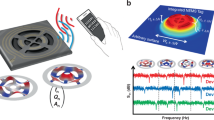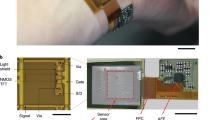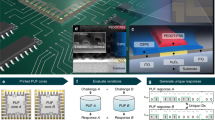Unique surface imperfections serve as an easily identifiable feature in the fight against fraud.
Abstract
We have found that almost all paper documents, plastic cards and product packaging contain a unique physical identity code formed from microscopic imperfections in the surface. This covert ‘fingerprint’ is intrinsic and virtually impossible to modify controllably. It can be rapidly read using a low-cost portable laser scanner. Most forms of document and branded-product fraud could be rendered obsolete by use of this code.
This is a preview of subscription content, access via your institution
Access options
Subscribe to this journal
Receive 51 print issues and online access
$199.00 per year
only $3.90 per issue
Buy this article
- Purchase on Springer Link
- Instant access to full article PDF
Prices may be subject to local taxes which are calculated during checkout

Similar content being viewed by others
References
Smith, J. R. & Sutherland, A. V. Proc. AutoID'99, Workshop on Automatic Identification Advanced Technologies 79–83 (IEEE, New York, 1999).
van Renesse, R. in European Convention on Security and Detection 45–49 (Institution of Electrical Engineers, London, 1995).
Indeck, R. S. & Glavinas, E. IEEE Trans. Magn. 29, 4095–4097 (1993).
Pappu, R., Recht, B., Taylor, J. & Gershenfeld, N. Science 297, 2026–2030 (2002).
Goodman, J. W. Topics in Applied Physics: Laser Speckle and Related Phenomena (ed. Dainty, J. C.) vol. 9 (Springer, Berlin, 1984).
Leonard, L. C. & Toal, V. Opt. Lasers Eng. 30, 433–440 (1998).
Sjodahl, M. & Larsson, L. Opt. Lasers Eng. 42, 193–201 (2004).
Seo, Y. B. J. Pulp Paper Sci. 25, 321–325 (1999).
Briers, J. D., Richards, G. & He, X. W. J. Biomed. Opt. 4, 164–175 (1999).
Author information
Authors and Affiliations
Corresponding author
Ethics declarations
Competing interests
This work was funded by an external company, Ingenia Holdings. One or more of the authors have consultancy agreements with that company. Patents have been filed on the work described in the paper and an exploitation company registered. Some of the authors own small shareholdings in that company. The total share ownership of all the authors combined does not exceed 10%.
Supplementary information
Rights and permissions
About this article
Cite this article
Buchanan, J., Cowburn, R., Jausovec, AV. et al. ‘Fingerprinting’ documents and packaging. Nature 436, 475 (2005). https://doi.org/10.1038/436475a
Published:
Issue Date:
DOI: https://doi.org/10.1038/436475a
This article is cited by
-
Extracting particle size distribution from laser speckle with a physics-enhanced autocorrelation-based estimator (PEACE)
Nature Communications (2023)
-
An all-in-one nanoprinting approach for the synthesis of a nanofilm library for unclonable anti-counterfeiting applications
Nature Nanotechnology (2023)
-
Fraud detection from paper texture using Siamese networks
Signal, Image and Video Processing (2023)
-
Construction of anti-counterfeiting pattern on the cellulose film by in-situ regulation strategies
Cellulose (2022)
-
Secret-free security: a survey and tutorial
Journal of Cryptographic Engineering (2022)
Comments
By submitting a comment you agree to abide by our Terms and Community Guidelines. If you find something abusive or that does not comply with our terms or guidelines please flag it as inappropriate.



